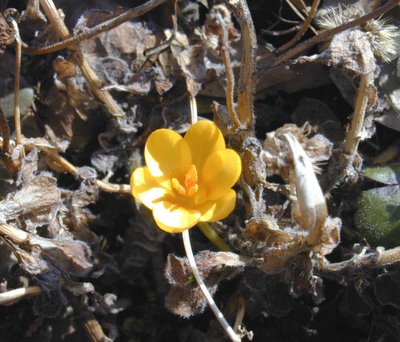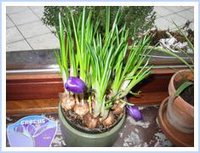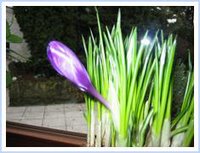:::::::::::::::::::::::::::::::::::::::::::::::::::::::::::::::::::::::::::::::::::::::::::::::::::::
Crocus
***** Location: Europa, other regions
***** Season: Early Spring
***** Category: Plant
*****************************
Explanation

Photo © Gabi Greve, 2006
Crocus, kurokkasu クロッカス
saffron blooming in spring, haruzaki safuran 春咲きサフラン
Crocus chrysanthus, Crocus sieberi, Crocus tommasinianus, Crocus sativus and many more. 60 varieties are known.
Crocus (crocuss) are one of the earliest flowers in spring, flowering on sunny spots, thus in haiku they convey a feeling of expectation, brightness, hope.
The plant is native to Southern Europe and Asia. The word CROCUS derives from the latin word meaning Saffron. Because of its strong yellow color, it is a symbol of light and superiority. The robes of kings have been dyied in this color. It is also a symbol of gold and true love.
Gabi Greve
:::::::::::::::::::::::::::::::::::::::::::::::::::::::::::::::::::::::::::::::::::::::::::::::::::::
Saffron Crocus
Crocus sativum, Family: Iridaceae
BUT
kigo for late autumn.

safuran サフラン saffron
. . . . . 洎夫藍(さふらん)
safuran no hana サフランの花 (さふらんのはな) saffron flower
akizaki safuran 秋咲きサフラン(あきざきさふらん)saffron flowering in autumn
Zephyranthes candida. Reinweiße Zephirblume
This is a variety with white blossoms.

Colichium autumnae, autumn saffron, meadow saffron
Other autumn saffron have violet flowers and stamen.
They are collected, dried and prepared for traditional Chinese medicine.
This plant has been introduced from Europe via China to Japan fairly recently around 1860 and is thus a rather new kigo.

洎夫藍の紫乾して漢方医
safuran no shibe kawakashite kanpoo i
he dries the stamen
of autumn saffron -
doctor for Chinese medicine
Yasaki Masako 矢崎正子
source : NHK Haiku October 2012
. Chinese Medicine (kanpo 漢方薬) .
kigo for all summer
tamasudare no hana 玉簾の花 (たますだれのはな)
flowers of Zephyranthes candida
:::::::::::::::::::::::::::::::::::::::::::::::::::::::::::::::::::::::::::::::::::::::::::::::::::::
There are actually many different species of crocuses. However, in most gardening catalogues you will normally see only two categories of crocuses mentioned: the Giant Dutch Crocuses, and everything else (sometimes the term Snow Crocuses is used).
Look at a great photo collection.
http://www.theplantexpert.com/springbulbs/Crocus1.html
*****************************
Worldwide use
Germany
Krokus und Herbstzeitlose
LINK with many photos .
http://www.coolphotos.de/fruehling_krokusse/
:::::::::::::::::::::::::::::::::::::::::::::::::::::::::::::::::::::::::::::::::::::::::::::::::::::
North America
It was the European settlers who named these little flowers crocuses; not because they are related to the crocuses of Europe, but because they are the first to bloom like the crocuses of home.
Prior to European settlement Blackfoot Indians called them "napi" which translates to "old man," and is thought to be a reference to the grey feathery seeds which arise above the plants in June.
The familiar prairie crocus (Anemone patens) is a member of the buttercup family and should not be confused with the white, yellow and mauve crocuses we plant with our fall bulbs. These horticultural crocuses are also the source of saffron, one of the world's most expensive spices. The stigmas of approximately 150 crocuses must be harvested to obtain a single gram of saffron. http://gardenline.usask.ca/misc/crocus.html
*****************************
Things found on the way
*****************************
HAIKU
sludge
after the snow melt --
first purple crocuses


la gadoue
après la fonte de la neige --
premiers crocus violets
© Photo and Haiku
Marcel Peltier, Belgium, 2006
xxxxxxxxxxxxxxxxxxxxxxxxxxxxx
surprised
little yellow iris
among crocus buds
Pia So'Sua von Prondzynski, Germany
xxxxxxxxxxxxxxxxxxxxxxxxxxxxx
first yellow crocus-
i release
my winter heart
pamela a. babusci
Look at the photo and more haiku in the
Photo Haiku Gallery
xxxxxxxxxxxxxxxxxxxxxxxxxxxxx
first crocus -
down the hillside trail
spring runoff
paul m
first crocus -
my grumpy neighbor
smiles
doris kasson
Shiki Kukai 1998
http://shiki1.cc.ehime-u.ac.jp/~shiki/kukai/kukai32-1.html
:::::::::::::::::::::::::::::::::::::::::::::::::::::::::::::::::::::::::::::::::::::::::::::::::::

première poussée
le crocus hors de terre
dans le soleil
Nekojita, France, May 2008
first push
the crocus out of the ground
into the sunlight
Tr. Dana-Maria Onica
Translating Haiku Forum
first to sprout
one crocus alone
in the sun
Tr. Bethel Prescott
Kigo Hotline
:::::::::::::::::::::::::::::::::::::::::::::::::::::::::::::::::::::::::::::::::::::::::::::::::::::

first crocus -
this shape and color
of hope
Gabi Greve, March 1, 2012
*****************************
Related words
***** World Kigo Database: Spring (haru)
***** World Kigo Database: Autumn flowers
[ . BACK to WORLDKIGO . TOP . ]
:::::::::::::::::::::::::::::::::::::::::::::::::::::::::::::::::::::::::::::::::::::::::::::::::::::






